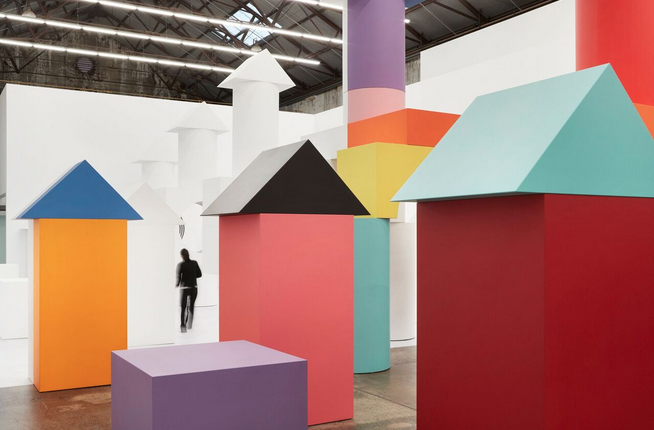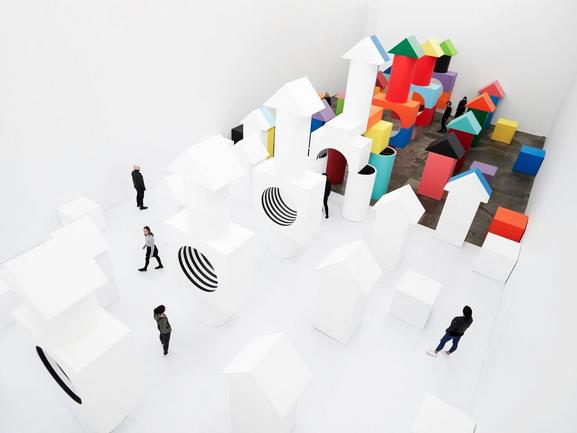Daniel Buren, Like Child’s Play, installation view Carriageworks (2018). Photo credit: Zan Wimberley.
With each major installation, Bay 21 at Carriageworks seems to expand and contract. It’s a white cube hovering in an industrial shell.
The latest intervention in this space has been by French artist Daniel Buren, famed for his striped installations. The ten- times Venice Biennale participant (who won the Golden Lion in 1986, likened to an Academy Award in the visual arts scene) has been in Sydney for a bit of play time.
Buren began making artworks in Paris in the 1960s, and his pieces first appeared in the public domain as early as 1968, when, as Carriageworks’ Curator Kelly McDonald observed, ‘he pasted 200 posters around Paris’ streets in a challenge to the assumed authority that comes with the exhibition of artworks within galleries and museums’.
Buren has recreated his installation Like Child’s Play (Comme Un Jeu d’Enfant), first unveiled in 2015 at Strasbourg’s Musée d’Art Moderne et Comtemporain in France. It was thereafter presented in Italy and Mexico (in the later country in a venue which, like Carriageworks, was curiously also a building for trains, but new) before premiering in Sydney.
The piece is constructed from 100 oversized blocks – half brightly coloured, the rest, in a nod to minimalism, in black and white.
‘They’re never positioned the same way. It is very different each time I make this work, but with the same exact elements,’ Buren revealed at a media preview this week.
Small in stature but big in energy, the 80-year-old artist said Like Child’s Play was inspired by the famous wooden blocks of Friedrich Froebel, the 19th-century German theorist credited as the inventor of kindergartens.
‘They are a repetition of the 13 different colours in the box – so the colour is not even something I make myself because I like or dislike it. It is the exact colour of these toys,’ Buren said.

Daniel Buren in Sydney (2018). Photo: Zan Wimberley.
Buren has recreated Froebel’s blocks on steroid – a kind of adventure playground of geometry. He said: ‘For me, colour is pure thought, and therefore completely inexpressible, every bit as abstract as a mathematical formula or a philosophical concept.’
Carefully arranged – half a metre here, a metre there, a stacked triangle on a rectangle and a corridor of circles – one can easily forgive Buren for his geeky obsession with calculations. After all, his obsession with precision and proportions has been around for a while and has delivered some of the world’s most exciting public art.
Walking into this installation, the viewer moves from the white zone into colour – almost like an adult being given permission to play. The room is divided from top to bottom – most obviously by colour shift – and dissected left to right, with the arrangement of the forms perfectly mirroring each other.
Some forms sit at what I might call “glass height”, that convenient body height where one might rest an arm or place a glass. For Buren that 1m x 1m x 1m cube is the primary building block.
He said: ‘We use the space from beginning to the end, from right and left, and to the very top of the white walls of this Bay 21. The principal of using space is the reference I put upon it – 1m x 1m x 1m – and from that all the sizes are an enlargement of the existing cube or division of it.’

Daniel Buren, Like Child’s Play, installation view Carriageworks (2018). Photo: Zan Wimberley.
Walking through the work, one can’t help feeling like you are moving through a built city – a little bit fantastical, a little bit reduced. It is not surprising to learn that, for two decades, Buren has worked with circuses in France creating sets and spaces for performers.
At moments there is a void-like quality as the white forms fade into white walls and white floor. At another point, viewers peer down a passage or tunnel created by round windows in square shapes – each lined with Buren’s iconic black and white stripes. It is incredibly Instagrammable.
Buren has been quoted saying: ‘Stripes have no meaning as such. They are simply very ductile instruments for seeing.’
Buren first employed stripes in 1967 – a very specific 8.7cm wide vertical stripe – as a starting point for research into what painting is, how it is presented and more broadly the physical and social environment in which an artist works.

Daniel Buren, Like Child’s Play, installation view Carriageworks (2018). Photo: Zan Wimberley.
All Buren’s interventions are created in situ, and this one required the original blocks to be freighted to Sydney – not recreated.
The project has been supported by Melbourne dealer, Anna Schwartz, who ran Bay 21 as a gallery space until 2015.
Schwartz has committed to a five-year exhibition program in partnership with Carriageworks to bring major international artists and site responsive exhibitions to Australia.
4 1/2 stars: ★★★★☆
Daniel Buren: Like Child’s Play
Carriageworks, Eveleigh
7 July – 12 August 2018
carriageworks.com.au





